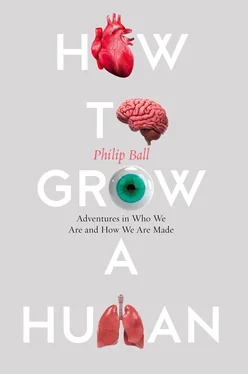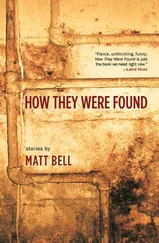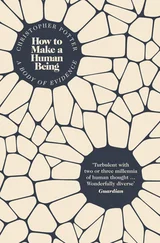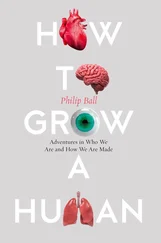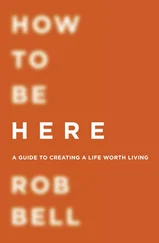Virchow and his contemporaries were already coming to appreciate that cells are more than fluid-filled sacs. In 1831, the Scottish botanist Robert Brown reported that plant cells have a dense internal compartment that he called a nucleus. 2By Virchow’s time, cells were considered to have at least three components: an enclosing membrane, a nucleus, and a viscous internal fluid that the Swiss physiologist Albert von Kölliker named the cytoplasm. ( Cyto- or cyte means cell, and we’ll see this prefix or suffix a lot.)
Kölliker was one of the first to study cells microscopically using the technique of staining: treating them with dyes that are absorbed by cell components to make their fine structure more visible. He was a pioneer in the field of histology , the study of the anatomy of tissues and their cells. Kölliker was particularly interested in muscle cells, and he showed that these are of more than one type. One variety has a stripy (“striated”) appearance when stained, and Kölliker noticed that striated muscle cells also contain many tiny granules, later identified as another component of animal cells that were named mitochondria in 1898. Around the same time, other substructures of the cell’s interior were recognized: the disorderly, spongelike folded membrane called the endoplasmic reticulum, and the Golgi apparatus, named after the Italian biologist Camillo Golgi. A vigorous debate began about whether the cell’s jelly-like internal medium – called the protoplasm – is basically granular, reticular (composed of membrane networks) or filamentary (full of fibrous structures). All of these options were observed, and the truth is that it depends on when and where you look at a cell.

Images of onion cells drawn in 1900 by the biologist Edmund Beecher Wilson. These show some of the internal structures seen at different times in different cells. The single dense blob in several of these is the nucleus. Sometimes this seemed to break up into threads or blobs, perhaps in the process of cell division. What was going on in there?
All this internal structure led the zoologist Edmund Beecher Wilson to express regret that the term “cell” had ever been coined. It was a misnomer, he said – “for whatever the living cell is, it is not, as the word implies, a hollow chamber surrounded by solid walls.” Some others wondered if the cell was really the fundamental entity it had been supposed to be, not least because a cell membrane was not always visible under the microscope. Perhaps it was actually these organized contents in the protoplasm that were the real stuff of life? “We must be careful,” warned zoologist James Gray in 1931, “to avoid any tacit assumption that the cell is the natural, or even the legitimate, unit of life and function.” 3
At any rate, the cell contained so much stuff. What was it all for?
It was becoming clear, too, what some of the key chemical components of cells are. Chemists interested in the processes of life – by the end of the century that topic was known as biochemistry – had figured out that they contain chemical agents called enzymes that carry out its characteristic panoply of metabolic reactions. Some enzymes, for example, allow yeast to ferment sugar into alcohol. In 1897, German chemist Eduard Buchner showed that intact cells weren’t necessary for that to happen: the “juice” that could be extracted from yeast cells could produce fermentation on its own, presumably because it still carried the crucial enzymes, undamaged, within it.
These molecular ingredients, like workers in a city, had to be organized, segregated, orchestrated in the time and place of their actions and motions. Chemical reactions in the cell have to happen in the proper order and in the right location; things can’t be the same everywhere in the cell. And so the “social” view of bodies as communities of cells was repeated for the single cell itself: it was a sort of factory populated by cooperating enzymes and other molecules. This hidden machinery enables a cell to persist and maintain itself, to take in substances and energy from the environment and use them to carry out the metabolic reactions without which there is only death. 4
At the turn of the century, the substructure and organization on which the animation of cells depends was largely beyond the resolving power of the microscopes. But it was clear enough that not all cells are alike in their composition and structure. Bacteria and protists have rather little in the way of visible internal organization. They belong to a class of micro-organisms called prokaryotes, and they are typically round or elongated and sausage-shaped. The language of biological classification is always a little presumptuous, but it takes nothing away from bacteria to say that their cells are structurally relatively “simple”. They lack a nucleus – hence the label “prokaryotes”, meaning “pre-nucleus”. (More presumption – as though bacteria just haven’t yet discovered the wisdom of having a nucleus but will wake up to it one day. In fact, bacteria have existed for longer than eukaryotes; they and other prokaryotes dominate much of the planet’s ecology, and evidently have no need of “greater sophistication” in order to thrive.)
Human cells, along with those of other animals, plants, fungi and yeast, are said to be eukaryotes: a term that simply connotes that their cells have a nucleus. Eukaryotic organisms may be multicelled, like us, or single-celled, like yeast. The latter is an example of a “lower” eukaryote: more presumption, of course, but meaning that the degree of organization in the cell is less than that evident in the higher eukaryotes like peas, fruit flies and whales.
For now we can set prokaryotes aside. There is, mercifully, no need either to look in detail at what all the complex structure of the human cell is about, other than to say that it can be usefully regarded as a compartmentalization of the processes of existence. Membrane-wrapped substructures of the cell are called organelles, and each can be somewhat crudely considered to carry out a specific task. Mitochondria are the regions where a eukaryotic cell produces its energy, in the form of small molecules that release stored chemical energy when transformed by enzymes. The Golgi apparatus functions as a kind of cellular post office, processing proteins and dispatching them to where they are needed. The nucleus is where the chromosomes are kept: the material encoding the genes that are passed on when a cell divides or an organism reproduces. What we do need to hear more about, very shortly, are those chromosomes, because they are an important part of what defines you as an individual, and absolutely vital for orchestrating the life processes that enabled you to grow and which sustain you daily.

The human cell.
By the early twentieth century, it was clear that what sets living matter apart from the inanimate is not merely a question of composition: of what life is made of. Neither is it just a question of structure. Organisms and cells clearly did have a hierarchy of significant, specific yet hard-to-interpret structures reaching down to the microscopic and beyond. And that mattered. But the real reason living matter is not equivalent to some other state of matter such as liquids and gases is that it is dynamic : always changing, always in the process of doing something, never reaching a steady equilibrium. Staying alive is not a matter of luxuriating in the state of aliveness but is a relentless task of keeping balls in the air.
Читать дальше
